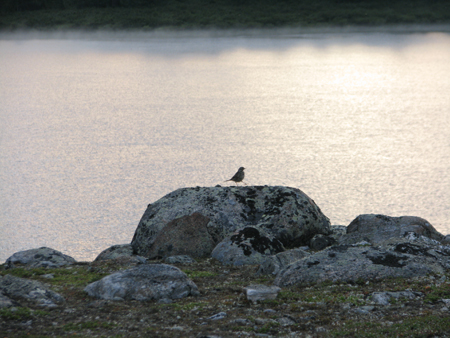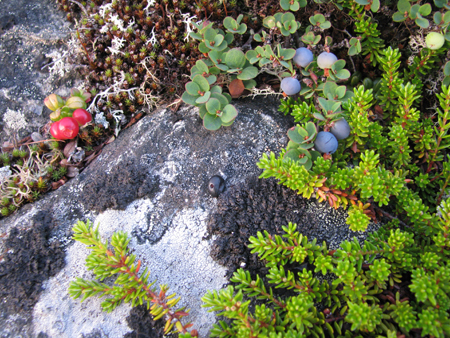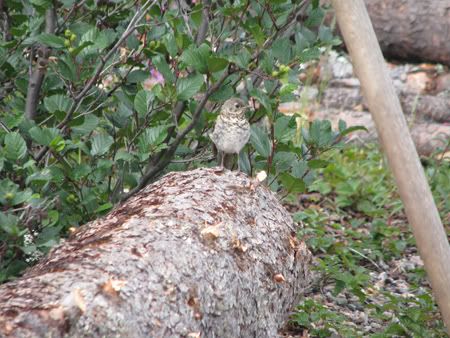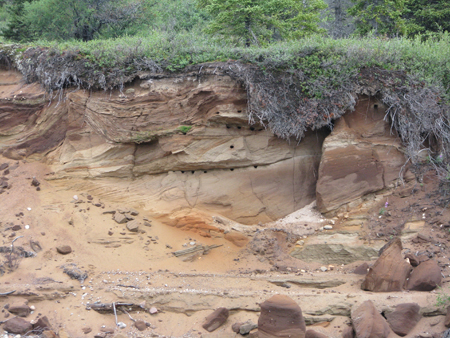
American Pipit
Credit: Jeff Wells
This is a long overdue blog installment about the birds that I observed on my trip to the George River of northern Quebec from August 8-13, 2010.
After seven hours of flying in a small and very loud floatplane, one of the first sensations that hit me upon arrival at Mushuanipi (Indian House Lake) on the George River of northern Quebec was the quiet.
Here's an idea of how loud it was on the plane:
Even the sounds of camp life and human conversations seemed small and muffled, enveloped as we were in the vast openness of the Ungava peninsula. Because it was August (Aug 8-13 2010) and the end of the nesting season, I expected that there would be little bird song activity and that fall migration would be well underway. So I was pleased to hear, the first morning, the occasional songs of Northern Waterthrush, Blackpoll Warbler, and White-crowned Sparrow. Here are a couple of kind of lousy recordings of Northern Waterthrush and White-crowned Sparrow from the trip that I did on my digital camera.
My ornithological explorations were geographically limited with most of my observations coming from the area immediately surrounding the encampment. I did spend one afternoon near the mouth of a small river across from the camp and another hiking from Wedge Point back to the camp. Although much of the time at Mushuanupi was busy with workshops and discussions (and I was slowed by a touch of the flu), I was able to observe birds each morning and evening for several hours as it was quite light from around 4 AM until perhaps 10 PM.
Among the most common birds around our encampment were White-crowned Sparrows. The alder thickets along the shorelines were busy with White-crowns, mostly immature. Their calls, and an occasional song , were the soundtrack of our time there. Often we would see small groups of White-crowns hopping out into the open barren ground from the alder thickets to feed on the abundant berries of ground plants like the crowberries, blueberries, bearberries, and others.

Berries were abundant in the area
Credit: Jeff Wells

Gray-cheeked Thrush
Credit: Jeff Wells
The abundance of berries was impressive as was the number of birds that were making use of them. It was interesting watching American Robins hopping around on the tundra-like habitat as if they were on a suburban lawn down south looking for worms, But instead of pulling up and gobbling worms, they would reach down and grab a berry and quickly swallow it. There were lots of Gray-cheeked Thrushes doing the same thing. Although I can't say with 100% certainty that they were eating berries, I did see occasional Savannah Sparrows and American Pipits as well as single Fox and Lincoln’s Sparrows in the same feeding flocks. I am also pretty sure that Spotted Sandpipers were feeding on the berries as I flushed them a number of times from the areas with the berries and I saw few insects there on which they could have fed.
Northern Waterthrush was certainly the most ubiquitous warbler around camp, perhaps because there were at least three males still regularly singing and because their loud “chink” calls rang out from the alder thickets. I heard Blackpoll Warblers singing fairly often as well and saw a few immature-plumaged individuals. I was never able to verify this but I thought I heard the buzzy flight calls of Yellow Warblers several times and I distantly observed what appeared to be a Yellow Warbler at one point.
Several times I found small groups of Common Redpolls but they were very secretive, staying in the thickets and being generally inconspicuous. American Tree Sparrows were around the camp as well and singing in the mornings especially vigorously. I found one family group in which the adults were feeding recently fledged young.
One of the things I found most surprising considering that we were next to a major river which in that section was more like a large lake (hence the English name of Indian House Lake) was how few waterbirds and waterfowl I saw. Several times a day one or two Herring Gulls would fly by and there was a small flock of Red-breasted Mergansers that we saw a few times. On two occasions a breeding plumaged Common Loon flew over and a single Arctic Tern passed overhead one day. We did see a single female Surf Scoter on a small pond near camp. I regularly heard the “kreep” calls of migrating Least Sandpipers and once some Semipalmated Sandpipers. Spotted Sandpipers were quite common along the shores.
I hadn’t realized how far north Bank Swallows breed, so I was delighted to observe some over the river and then later to be shown a nearby nesting colony site (by then abandoned for the season) in a high riverbank.

Bank Swallow colony
Crecit: Jeff Wells
One of the most common birds of northern towns was almost non-existent here—that is the Common Raven. I saw only a single one that one day dropped from the sky about 500 yards from camp, hopped around on the ground for a few seconds and then took off and disappeared over the hills. I did see a single Golden Eagle one day distantly over the higher elevations to the east but no other raptors. Despite much searching neither myself nor fellow ornithologist Marcel Darveau had the good fortune to find a Willow Ptarmigan but one of the participants came back to camp on the last day with a wonderful video of one they had found not far from camp. Marcel and I had to be satisfied with seeing the video which we would have shared with you but it was lost in a computer failure before it could be backed up.

